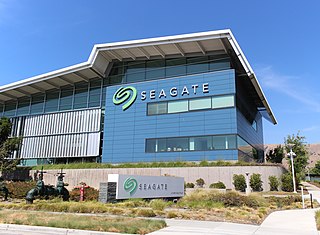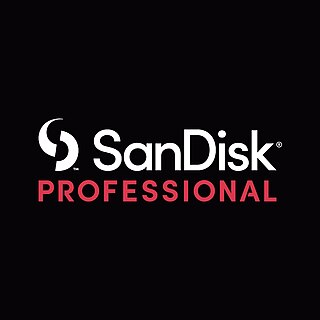Related Research Articles

A hard disk drive (HDD), hard disk, hard drive, or fixed disk, is an electro-mechanical data storage device that stores and retrieves digital data using magnetic storage with one or more rigid rapidly rotating platters coated with magnetic material. The platters are paired with magnetic heads, usually arranged on a moving actuator arm, which read and write data to the platter surfaces. Data is accessed in a random-access manner, meaning that individual blocks of data can be stored and retrieved in any order. HDDs are a type of non-volatile storage, retaining stored data when powered off. Modern HDDs are typically in the form of a small rectangular box.

Western Digital Corporation is an American computer drive manufacturer and data storage company, headquartered in San Jose, California. It designs, manufactures and sells data technology products, including data storage devices, data center systems and cloud storage services.

Seagate Technology Holdings plc is an American data storage company. It was incorporated in 1978 as Shugart Technology and commenced business in 1979. Since 2010, the company has been incorporated in Dublin, Ireland, with operational headquarters in Fremont, California, United States.

Network-attached storage (NAS) is a file-level computer data storage server connected to a computer network providing data access to a heterogeneous group of clients. The term "NAS" can refer to both the technology and systems involved, or a specialized device built for such functionality.
In information technology, a backup, or data backup is a copy of computer data taken and stored elsewhere so that it may be used to restore the original after a data loss event. The verb form, referring to the process of doing so, is "back up", whereas the noun and adjective form is "backup". Backups can be used to recover data after its loss from data deletion or corruption, or to recover data from an earlier time. Backups provide a simple form of disaster recovery; however not all backup systems are able to reconstitute a computer system or other complex configuration such as a computer cluster, active directory server, or database server.
NetApp, Inc. is an American data storage and data management services company headquartered in San Jose, California. It has ranked in the Fortune 500 from 2012 to 2021. Founded in 1992 with an initial public offering in 1995, NetApp offers cloud data services for management of applications and data both online and physically.

A disk enclosure is a specialized casing designed to hold and power hard disk drives or solid state drives while providing a mechanism to allow them to communicate to one or more separate computers.
In computing, a hybrid drive is a logical or physical storage device that combines a faster storage medium such as solid-state drive (SSD) with a higher-capacity hard disk drive (HDD). The intent is adding some of the speed of SSDs to the cost-effective storage capacity of traditional HDDs. The purpose of the SSD in a hybrid drive is to act as a cache for the data stored on the HDD, improving the overall performance by keeping copies of the most frequently used data on the faster SSD drive.
A NetApp FAS is a computer storage product by NetApp running the ONTAP operating system; the terms ONTAP, AFF, ASA, FAS are often used as synonyms. "Filer" is also used as a synonym although this is not an official name. There are three types of FAS systems: Hybrid, All-Flash, and All SAN Array:
- NetApp proprietary custom-build hardware appliances with HDD or SSD drives called hybrid Fabric-Attached Storage
- NetApp proprietary custom-build hardware appliances with only SSD drives and optimized ONTAP for low latency called ALL-Flash FAS
- All SAN Array build on top of AFF platform, and provide only SAN-based data protocol connectivity.

HGST, Inc. was a manufacturer of hard disk drives, solid-state drives, and external storage products and services.

A hard disk drive failure occurs when a hard disk drive malfunctions and the stored information cannot be accessed with a properly configured computer.
A fire-resistance rating typically means the duration for which a passive fire protection system can withstand a standard fire resistance test. This can be quantified simply as a measure of time, or it may entail other criteria, involving evidence of functionality or fitness for purpose.
In 1953, IBM recognized the immediate application for what it termed a "Random Access File" having high capacity and rapid random access at a relatively low cost. After considering technologies such as wire matrices, rod arrays, drums, drum arrays, etc., the engineers at IBM's San Jose California laboratory invented the hard disk drive. The disk drive created a new level in the computer data hierarchy, then termed Random Access Storage but today known as secondary storage, less expensive and slower than main memory but faster and more expensive than tape drives.

A solid-state drive (SSD) is a solid-state storage device that uses integrated circuit assemblies to store data persistently, typically using flash memory, and functions as secondary storage in the hierarchy of computer storage. It is also sometimes called a semiconductor storage device, a solid-state device, or a solid-state disk, even though SSDs lack the physical spinning disks and movable read–write heads used in hard disk drives (HDDs) and floppy disks. SSD also has rich internal parallelism for data processing.
NTBackup is the built-in backup application introduced in Windows NT 3.51 and included in Windows NT 4.0, Windows 2000, Windows XP, and Windows Server 2003. NTBackup comprises a command-line utility and a set of wizard interfaces that provide multiple options to create, customize, and manage backups, and it is integrated with Shadow Copy and Task Scheduler. NTBackup creates backups in a proprietary BKF file format to external sources including floppy disks, hard drives, tape drives, and ZIP drives.
Hardware-based full disk encryption (FDE) is available from many hard disk drive (HDD/SSD) vendors, including: ClevX, Hitachi, Integral Memory, iStorage Limited, Micron, Seagate Technology, Samsung, Toshiba, Viasat UK, Western Digital. The symmetric encryption key is maintained independently from the computer's CPU, thus allowing the complete data store to be encrypted and removing computer memory as a potential attack vector.

SanDisk Professional is a brand of Western Digital that produces external storage products designed and marketed for the Macintosh, creative pro, photography and A/V markets. Its USB, FireWire, eSATA, SAS, SCSI Thunderbolt, and Fibre Channel systems support all levels of audio/video production.
The Opal Storage Specification is a set of specifications for features of data storage devices that enhance their security. For example, it defines a way of encrypting the stored data so that an unauthorized person who gains possession of the device cannot see the data. That is, it is a specification for self-encrypting drives (SED).
Shingled magnetic recording (SMR) is a magnetic storage data recording technology used in hard disk drives (HDDs) to increase storage density and overall per-drive storage capacity. Conventional hard disk drives record data by writing non-overlapping magnetic tracks parallel to each other, while shingled recording writes new tracks that overlap part of the previously written magnetic track, leaving the previous track narrower and allowing higher track density. Thus, the tracks partially overlap similar to roof shingles. This approach was selected because, if the writing head is made too narrow, it cannot provide the very high fields required in the recording layer of the disk.
References
- ↑ "ioSafe Contact Information". ioSafe. Retrieved July 30, 2018.[ self-published source ]
- ↑ "Management Team".
- ↑ "April 2008: ioSafe introduces S2 disaster-proof storage device, providing simple disk-based disaster recovery for critical business data" (Press release). ioSafe. April 7, 2008. Archived from the original on December 1, 2008.[ self-published source ]
- 1 2 3 4 Shilov, Anton (July 26, 2018). "CRU Acquires ioSafe, Creating Disaster-Resistant Storage Powerhouse". AnandTech. Purch. Retrieved July 30, 2018.
- ↑ "IoSafe N2 NAS Review".
- 1 2 3 4 Ngo, Dong (January 6, 2009). "ioSafe Solo: Disaster-proof external hard drive". c|net. Retrieved July 30, 2018.
- 1 2 3 "ioSafe Selects Fujitsu to Deliver First Disaster-Protected Internal Hard Drives" (Press release). Fujitsu. August 26, 2008. Retrieved July 30, 2018.